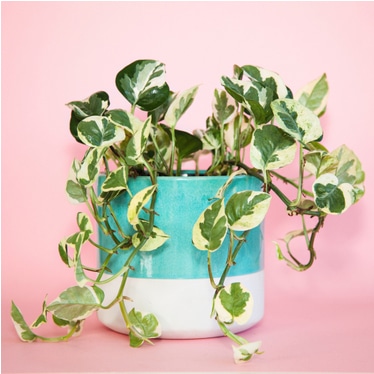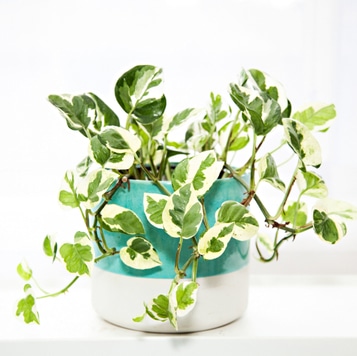The snow queen pothos (Epipremnum Aureum) is a beautiful plant with green and white foliage. The pothos plant does not need much care and can be grown as a houseplant or outdoors in USDA zones 10 to 12. It’s an ideal houseplant for beginners and people who do not have time to take care of plants. Read this blog post to find out how you can grow your own Snow Queen Pothos!
What is a Snow Queen Pothos?

Snow Queen Pothos or Epipremnum is a beautiful foliage plant with shiny, waxy healthy leaves. The foliage is very light colored and can be white or cream with specks of green. These plants got their name because they look like a snow covered hillside. They are part of the Araceae family of which has over 400 species of plants.
The snow queen pothos originates from many areas of Asia, including India and China. They can grow very large in the wild, commonly reaching 20 feet in height. When grown as a houseplant, they are unlikely to get as tall.
This easy-care houseplant makes a lovely gift for both novice and expert gardeners alike. Colorful vines of Snow Queen Pothos add warmth to any indoor space. In addition to being an attractive houseplant, it is also a popular outdoor landscape plant in tropical regions and can be successfully grown outdoors in USDA zones 10 to 12.
Snow Queen Pothos is commonly referred to as “Devil’s Ivy” or “Money Tree.” It is an easy-care houseplant that can grow well in bright indirect light areas and will thrive in most home environments.
This popular low maintenance plant grows into a fast-growing vine; it will climb, cling, and drape itself over other objects. Snow Queen Pothos pairs well with many other plants and looks stunning when paired with other varieties of pothos like Red Gold Pothos and Tricolor Pothos. The color variation between the different pothos makes them especially attractive when used together in one display.
It’s worth bearing in mind that the snow queen pothos is toxic to humans and animals if ingested. It can also cause skin irritation in some people. Keep your plant out of the reach of animals and young children, and be careful when handling your plant.
How to care for a snow queen pothos plant
Snow Queen Pothos requires moist soil at all times and tolerates a wide range of conditions – from low light levels to direct sun exposure. These plants are generally pest-free; occasionally, mealybugs might be visible on the stems or undersides of leaves when infestations develop. Here are some tips to help you grow and care for a thriving snow queen pothos plant.
Sunlight and Temperature
Place Epipremnum Aureum in indirect sunlight or grow lights; ensure it is not exposed to direct cold drafts or air conditioning units. Make sure that this plant is not exposed to drafts or direct cold air, as it’s only hardy outdoors down to 50° F (10° C). It may drop its leaves if exposed to very low temperatures; however, new leaves should grow back again once temps rise above 70° F (21° C). Although Snow Queen Pothos tolerates both full sun and low light conditions, this houseplant will benefit from more indirect light with slightly cooler temperatures.
Watering Requirements
Water the plant once a week, or when the soil has dried out, by thoroughly soaking the top 6 to 8 inches of soil and letting it drain completely. During hot summer months, watering may need to be done more frequently so that the soil remains moist at all times. Avoid letting the roots sit in water for long periods of time since this can lead to root rot.
Humidity
Aim to create a humidity of approximately 50% by misting your plant’s leaves daily. Snow Queen Pothos has a moderate to high tolerance for drought (i.e., it can survive long periods without water) but will perform best when given daily misting or placed on a humidity tray where the pot sits in 1 inch of water.
Soil
Constant soggy soils should be avoided. This houseplant prefers slightly acidic (5.8 – 6.2 pH), well-drained soils with an occasional dose of compost tea. You can also use a moss pole as support for your pothos to climb or grow it in a hanging basket from which its stems will trail and look beautiful.
Fertilization
Fertilize every month during spring and summer using a general-purpose houseplant fertilizer. Following the directions on the label carefully for application rates and the specific needs of the plant.
Pruning
Trim off any old, brown, or dead leaves using scissors or small pruning shears. Ensure that the leaves are clean by wiping them gently with a wet cloth or paper towel to remove dust and other airborne particles.
Pests
Watch for mealybugs, spider mites, and aphids. Mealybugs are oval-shaped, flat insects about 1 millimeter long with mouthparts that can pierce and suck the plant’s sap. They look like little pieces of cotton stuck on the plant’s stems and leaves. If found, treat plants with an insecticidal soap spray recommended for houseplants mixed according to package directions; rinse plants thoroughly after spraying since this treatment may damage foliage. Repeat every 7 to 10 days as needed until plants are once again pest-free.
Propagation
Snow Queen Pothos is commonly propagated through rooted stem cuttings. You can use a pair of sterilized scissors to cut a healthy leaf from your plant. Then either put it in a glass of water and wait until roots grow before planting or dip the end in rooting hormone and plant the cutting. After a few months, the roots will have established themselves, and you’ll see new growth. Only take cuttings from a plant that’s healthy and mature.
Conclusion
Snow Queen Pothos is an excellent, easy-to-care-for houseplant that has long been a favorite of indoor gardeners worldwide. It requires very little attention to thrive both indoors and outdoors. With proper care and regular watering and pruning, this versatile plant will thrive.
Place your Epipremnum Aureum in partial shade or bright indirect light rather than the full sun. This tropical plant is unique as it has light-colored variegated leaves and is a beautiful addition to any home or office interior.
